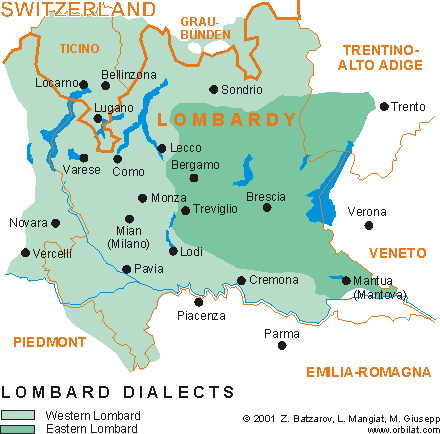This is an old revision of the document!
Table of Contents
Lombard in Italy
Language designations:
- In the language itself: lumbaart, or lengua lumbarda
- ISO 639-3 standard: language's ISO 639-3-LMO
Language vitality according to:
Linguistic aspects:
- Classification: Indo-European → Gallo-Italian. For more information, see language resource at Glottolog at http://glottolog.org/resource/languoid/id/lomb1257
- Script: Latin/Roman script
Language standardization
The Unesco Atlas of the World's Languages in Danger states that Lombard is a cluster of essentially homogeneous varieties, however, an accepted standard does not exist. It is disqualified from accessing higher domains and is exclusively used on an informal level.
Traditional orthography is based on French and therefore gives the reader a blurred first impression of Lombard phonology. Recently, a more phonetic orthography has evolved in Ticino and Valtellina - the Lombard regions along the common borders of Switerland and Italy - which is strongly influenced by German ortography, identifiable through the usage of umlaut marks ö and ü.
Concerning the mutual intelligibility with Italian, a case study found a 44,3% intelligibility rate of Lombard with standard Italian which is relatively low1).
The main institiution to research the Lombard variety is the CDE or Centro di dialettologia e di etnografia located in Bellinzona, Switzerland. In 2004, the CDE released a dictionary containing five volumes which cover all the Lombard varieties spoken in the Swiss areas. Lombard is furthermore used in television and radio broadcast in the area around Bellinzona. Italy does not have a comparable institution, which is why there is significantly less data on Lombard as spoken in Italy2).
Projects such as inlombard.eu.pn promote the collection of data on Lombard and its standardization by creating a linguistic observatory online.
Demographics
Language Area
The online encylopedia Orbis Latinus states that Lombard is spoken in the Italian region of Lombardy, the Novara province in Piedmont and in Switzerland (Canton Ticino and parts of Graubünden/Grigioni).
The preceding map shows the two main Lombard dialect clusters, Eastern and Western Lombard.
Western Lombard includes: Milanese, Lodigian, Comask, Ticinese, Varesotto, Novarese, Pavese, Vogherese, Lomellinese, Bosin (Ligurian-Lombard), Cremonese, Valtellinese and other minor varieties.
Eastern Lombard includes: Bergamask, Brescian, Cremask, Mantuan, Tirolian (Tyrolean) Lombard and other minor varieties.
Speaker numbers
The Unesco Atlas of the World's Languages in Danger states a number of 3,500,000 speakers based on various sources.
In Italy most of Lombard speakers are from the older generations. Younger generations use Italian due to media influences and school3).
Education of the language
History of language education:
There is no evidence of the usage of Lombard in formal education in neither Switzerland nor Italy.
Legislation of language education
Even though Italy signed and ratified the European Charter for Regional or Minority Languages (ECRML), it has failed to include Lombard in their protection program. Italy defines minority langauges legally by a national law, N. 482/99, which protects only twelve languages: Catalan, Occitan, Albanian, German, Greek, Slovene, Croatian, French, Francoprovençal, Friulian, Ladin and Sardinian 4).
Due to this very narrow definition this in practice means that there is no governmental support for Lombard in education in Italy. The Italian government considers Lombard a dialect of Standard Italian despite evidence of very limited mutual intelligibilty5).
Bodies controlling enforcement of educational laws:
According to a case study on Western Lombard, which is spoken by at least 2 Mio people - which is almost as many speakers as in the case of all the recognised minority languages of Italy put together - language planning, including the use of Western Lombard in education is carried out only by a number of uncoordinated initiatives by private bodies and institutions6). The most prominent one is the Circolo Filologico Milanese.
Education in practice
Bilingual education in Lombard and Italian has only been present in full-time education in a few experimental trials. In higher education, Lombard is virtually absent7).
Learning resources and educational institutions
There is no evidence of institutions that provide language education, teacher training, or any initiative to develop learning materials.
As mentioned above, the promotion of the Lombard language is mainly carried out by private actors. Websites such as Learn to Speak Lombard make an effort to bring together students of Lombard with native Lombard speakers. This exchange is not only limited to the linguistic aspects of Lombard but furthermore recognizes its distinct culture.
Projects like the Endangered Languages Project still fail to include Lombard in their database.



